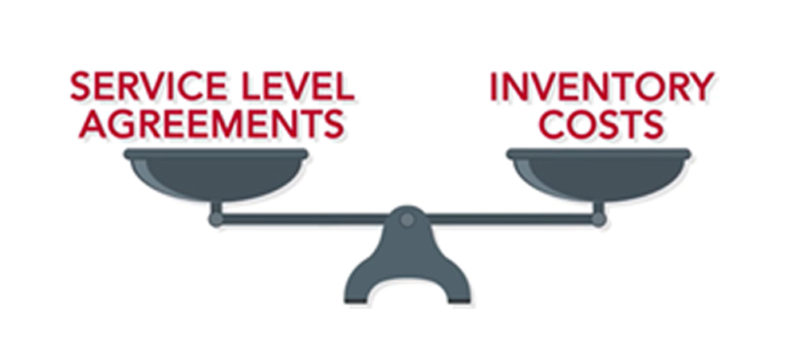The Right Part, Place, & Price: Part One
As a service organization, you live and die by your ability to meet Service Level Agreements (SLAs), which requires access to the right parts at the right time. But simply having all the right materials on hand isn’t enough to run a thriving business. That would make things too easy, wouldn’t it? In reality, your Service Supply Chain Team must balance the goals of your service delivery managers and the finance department: to exceed customer expectations in the most cost-effective way possible. You must strike that perfect balance where you spend just enough on inventory to ensure you service your customers optimally.
This two-part blog series explains how to create a cost-optimized service inventory plan. In part one, we’ll focus on parts forecasting with the help of installed base planning. Part two looks beyond the sheer need for materials and explains how to know what you should–and maybe shouldn’t–purchase from your inventory list. It also explains how to continuously improve your service inventory plan.

Installed Base Planning
When it comes to forecasting which parts you’ll need to service a particular region, relying on historical data alone has its shortcomings. For one, it assumes that customers’ needs remain consistent, which we know isn’t true. (Imagine using 2019 metrics to calculate demand for 2020!) Instead, we recommend adding an approach known as “installed base planning,” which uses future data (future known IB) and current data, like customer contracts, to generate demand forecasts for appropriate stocking locations.
The key data elements of an installed base record include:
- Part or product under contract
- Quantity of part or product under contract
- Start and end dates (optional)
- Service response requirement: “scheduled next business day” or “reactive same business day,” for example
- Physical location of installed base: city, state, country, and postal code
The last two bullet points help you pinpoint where to stock your service inventory once you know what customers will likely need. For contracts that require same-day parts availability, you can usually just use customers’ zip codes to find the closest stocking location. However, a region or country hub might work well for next-day requirements.

Field Replaceable Units
Inventory planning can’t just happen at the product level; it requires you to consider all the supporting parts, or field replacement units (FRUs), that go into making the product work. Sometimes the service contract data provides this info; sometimes it doesn’t. If not, you may need a service Bill of Materials (BOM) to help you zoom in on the customer contract. A service BOM should contain each FRU and FRU quantities associated with the product.
Add in Demand History to Generate the Forecast
Once you’ve used installed base planning to understand your customers’ needs, as well as where to stock your parts, you can incorporate historical demand data to generate your material forecast. Do this by calculating a forecast rate, the projected monthly demand quantity per contract for each individual FRU. This rate comes from the ratio of historical usage and installed base using regional or global data.
Here’s an example:
- From Installed Base data: Total of FRU supported in region (or globally) at the close of last period = 100
- From demand history: Total demand in region for FRU in the last 12 months = 84
- The forecasting rate: Average demand per period / total installed base = (84/12)/100 = .07
The forecast rate per installed base is .07. If in the next period your data indicates that you’re now supporting 32 installations through a particular stocking location, the forecast for that part and site is 32 x .07 or 2.24 demand units.
Great–now you’ve calculated a more accurate forecast, but there are a couple more layers left to optimize your plan. Check out part two of this series to learn how to determine what percentage of your material forecast you should actually purchase, and how to continuously improve your Parts Planning strategy.
Want more about Installed Base Planning? Check out this whitepaper!

John P. Peterson III, CPIM
Enterprise Solutions Consultant
John is a supply chain professional with more than 30 years of experience; 25 years focused on the service supply chain. In 20 years at Baxter Planning, he has leveraged his expertise and experience to drive Implementations, Consulting, and Planning engagements.
In his current Enterprise Solutions Consultant role, John serves as a subject matter expert providing technical demonstrations and solutions development in support of our sales team. He continues to do extensive work on independent inventory analysis projects, to date identifying over $1B in inventory optimization opportunity alongside the opportunity to reduce service misses due to inventory shortages by over 30%. In 2019, John was named as a Supply Chain “Pro to Know” by Supply Chain & Demand Executive magazine.
Certified in Planning and Inventory Management by ASCM (formerly APICS), The Association for Supply Chain Management, John has served on the Board of the Dallas and Austin, Texas ASCM (formerly APICS) chapters.
John lives in the Austin, Texas area with his wife, Lisa, with whom he has twin sons. He enjoys spending downtime motorcycling through the Texas Hill Country, drumming, and ‘glamping’ around Texas.

